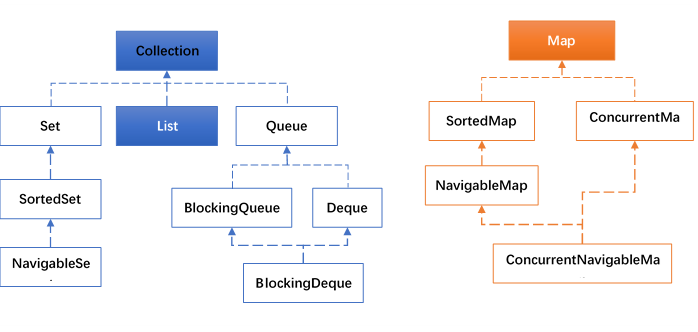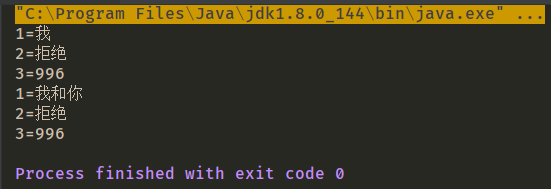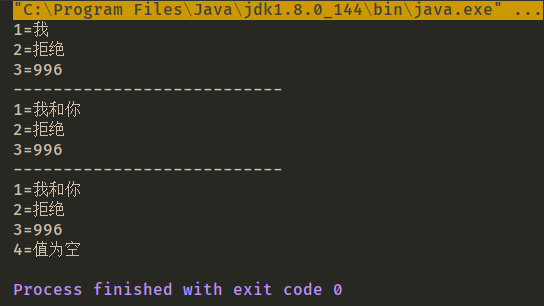Java8新增了java.util.funcion包,里面包含常用的函数接口,这是Lambda表达式的基础,Java集合框架也新增部分接口,以便与Lambda表达式对接。
Collections中的常用函数接口
Java集合框架的接口继承结构:

上图中蓝色标记和橙色标记的接口类,表示在Java8中加入了新的接口方法,由于继承关系,他们相应的子类也会继承这些方法。
下面用一张表列举这些方法
| 接口名 | Java8新加入的方法 |
| Collection | removeIf() spliterator() stream() parallelStream() forEach() |
| List | replaceAll() sort() |
| Map | getOrDefault() forEach() replaceAll() putIfAbsent() replace() computeIfAbsent() computeIfPresent() compute() merge |
这些新加入的方法大部分要用到java.util.function包下的接口,这就表明这些方法大部分都和Lambda表达式相关
Collections中的新方法
forEach()
该方法名为void forEach(Consumer action),作用是对容器中的每个元素执行action指定的动作,其中Consumer是个函数接口,里面只有一个待实现方法void accept(T t)
匿名内部类实现:
ArrayList<Integer> list = new ArrayList<>(Arrays.asList(3,6,9,10));
list.forEach(new Consumer<Integer>() {
@Override
public void accept(Integer integer) {
if (integer%3==0){
System.out.println(integer);
}
}
});
Lambda表达式实现:
//Lambda表达式实现 list.forEach(s->{ if (s%3==0){ System.out.println(s); } });
运行结果都是 :

removeIf()
该方法签名为boolean removeIf(Predicate filter),作用是删除容器中所有满足filter指定条件的元素,其中Predicate是一个函数接口,里面只有一个待实现方法boolean test(T t)。
匿名内部类以及Lambda表达式实现:
ArrayList<Integer> list = new ArrayList<>(Arrays.asList(3,6,9,10));
//匿名内部类实现
list.removeIf(new Predicate<Integer>() {
@Override
public boolean test(Integer integer) {
return integer%3==0;
}
});
System.out.println(list);
//Lambda表达式实现
list.removeIf(s->s%3==0);
System.out.println(list);
运行结果:

replaceAll()
该方法签名为void replaceAll(UnaryOperator<E> operator),作用是对每个元素执行operator指定的操作,并用操作结果来替换原来的元素。其中UnaryOperator是一个函数接口,里面只有一个待实现函数T apply(T t)。
匿名内部类以及Lambda表达式实现:
ArrayList<Integer> list = new ArrayList<>(Arrays.asList(3,6,9,10));
//匿名内部类实现
list.replaceAll(new UnaryOperator<Integer>() {
@Override
public Integer apply(Integer integer) {
if(integer%3==0){
return ++integer;
}
return --integer;
}
});
System.out.println(list);
//Lambda表达式实现
list.replaceAll(s->{
if(s%3==0){
return ++s;
}
return --s;
});
System.out.println(list);
运行结果:

sort()
该方法定义在List接口中,方法签名为void sort(Comparator c),该方法根据c指定的比较规则对容器元素进行排序。Comparator接口中有一个方法int compare(T o1, T o2)需要实现,该接口是个函数接口。
匿名内部类以及Lambda表达式实现:
ArrayList<Integer> list = new ArrayList<>(Arrays.asList(10,9,6,3));
//匿名内部类实现
Collections.sort(list, new Comparator<Integer>() {
@Override
public int compare(Integer o1, Integer o2) {
return o1-o2;
}
});
System.out.println(list);
//Lambda表达式实现
Collections.sort(list,(first,second)->first-second);
System.out.println(list);
运行结果:

spliterator()
方法签名为Spliterator<E> spliterator(),该方法返回容器的可拆分迭代器。从名字来看该方法跟iterator()方法有点像,我们知道Iterator是用来迭代容器的,Spliterator也有类似作用,但二者有如下不同:
Spliterator既可以像Iterator那样逐个迭代,也可以批量迭代。批量迭代可以降低迭代的开销。
Spliterator是可拆分的,一个Spliterator可以通过调用Spliterator trySplit()方法来尝试分成两个。一个是this,另一个是新返回的那个,这两个迭代器代表的元素没有重叠。
可通过(多次)调用Spliterator.trySplit()方法来分解负载,以便多线程处理。
stream()和parallelStream()
stream()和parallelStream()分别返回该容器的Stream视图表示,不同之处在于parallelStream()返回并行的Stream。Stream是Java函数式编程的核心类,具体内容后面单独介绍。
Map中的新方法
forEach()
该方法签名为void forEach(BiConsumer action),作用是对Map中的每个映射执行action指定的操作,其中BiConsumer是一个函数接口,里面有一个待实现方法void accept(T t, U u)。
Map<Integer,String> map = new HashMap<>();
map.put(1,"我");
map.put(2,"拒绝");
map.put(3,"996");
//匿名内部类实现
map.forEach(new BiConsumer<Integer, String>() {
@Override
public void accept(Integer integer, String s) {
System.out.println(integer+"="+s);
}
});
//Lambda表达式实现
map.forEach((key,value)-> System.out.println(key+"="+value));
运行结果:

该方法跟Lambda表达式虽然没关系,但是很有用。
方法签名为V getOrDefault(Object key, V defaultValue),作用是按照给定的key查询Map中对应的value,如果没有找到则返回defaultValue。使用该方法可以省去查询指定键值是否存在的麻烦。
匿名内部类实现方式以及Lambda表达式实现方式:
//Java7以前的做法
if (map.containsKey(4)) {
System.out.println(map.get(4));
} else {
System.out.println("noValue");
}
//Java8使用Map.getOrDefault()
System.out.println(map.getOrDefault(4,"noValue"));
运行结果:

putIfAbsent()
该方法跟Lambda表达式没关系,但是很有用。方法签名为V putIfAbsent(K key, V value),作用是只有在不存在key值的映射或映射值为null时,才将value指定的值放入到Map中,否则不对Map做更改.该方法将条件判断和赋值合二为一,使用起来更加方便。
remove()
我们都知道Map中有一个remove(Object key)方法,来根据指定key值删除Map中的映射关系;Java8新增了remove(Object key, Object value)方法,只有在当前Map中key正好映射到value时才删除该映射,否则什么也不做。
replace()
在Java7及以前,要想替换Map中的映射关系可通过put(K key, V value)方法实现,该方法总是会用新值替换原来的值.为了更精确的控制替换行为,Java8在Map中加入了两个replace()方法,分别如下:
-
replace(K key, V value),只有在当前Map中key的映射存在时才用value去替换原来的值,否则什么也不做。
-
replace(K key, V oldValue, V newValue),只有在当前Map中key的映射存在且等于oldValue时才用newValue去替换原来的值,否则什么也不做。
replaceAll()
该方法签名为replaceAll(BiFunction function),作用是对Map中的每个映射执行function指定的操作,并用function的执行结果替换原来的value,其中BiFunction是一个函数接口,里面有一个待实现方法R apply(T t, U u)。
匿名内部类实现方式以及Lambda表达式实现方式:
Map<Integer,String> map = new HashMap<>();
map.put(1,"我");
map.put(2,"拒绝");
map.put(3,"996");
//匿名内部类实现方式
map.replaceAll(new BiFunction<Integer, String, String>() {
@Override
public String apply(Integer integer, String s) {
if(s.equals("我")){
s = "他";
}
return s.toUpperCase();
}
});
map.forEach((key,value)-> System.out.println(key+"="+value));
//Lambda表达式实现方式
map.replaceAll((key,value)->{
if (value.equals("拒绝")) {
value = "Like";
}
return value.toUpperCase();
});
map.forEach((key,value)-> System.out.println(key+"="+value));
运行结果:

merge()
该方法签名为merge(K key, V value, BiFunction remappingFunction)。
作用是:
-
如果Map中key对应的映射不存在或者为null,则将value(不能是null)关联到key上;
-
否则执行remappingFunction,如果执行结果非null则用该结果跟key关联,否则在Map中删除key的映射。
参数中BiFunction函数接口前面已经介绍过,里面有一个待实现方法R apply(T t, U u)。
merge()方法虽然语义有些复杂,但该方法的用方式很明确,一个比较常见的场景是将新的错误信息拼接到原来的信息上,比如:
Map<Integer,String> map = new HashMap<>();
map.put(1,"我");
map.put(2,"拒绝");
map.put(3,"996");
map.forEach((key, value) -> System.out.println(key + "=" + value));
map.merge(1, "和你", (v1, v2) -> v1+v2);
map.forEach((key, value) -> System.out.println(key + "=" + value));
运行结果:

compute()
该方法签名为compute(K key, BiFunction remappingFunction),作用是把remappingFunction的计算结果关联到key上,如果计算结果为null,则在Map中删除key的映射。
Map<Integer,String> map = new HashMap<>();
map.put(1,"我");
map.put(2,"拒绝");
map.put(3,"996");
map.forEach((key, value) -> System.out.println(key + "=" + value));
//计算结果不是null
System.out.println("---------------------------");
map.compute(1, (k,v) -> v == null ? "值为空" : v.concat("和你"));
map.forEach((key, value) -> System.out.println(key + "=" + value));
//计算结果为null
System.out.println("---------------------------");
map.compute(4, (k,v) -> v == null ? "值为空" : v.concat("和你"));
map.forEach((key, value) -> System.out.println(key + "=" + value));
运行结果:

computeIfAbsent()
该方法签名为V computeIfAbsent(K key, Function mappingFunction)
作用是:只有在当前Map中不存在key值的映射或映射值为null时,才调用mappingFunction,并在mappingFunction执行结果非null时,将结果跟key关联。
Function是一个函数接口,里面有一个待实现方法R apply(T t)。
computeIfAbsent()常用来对Map的某个key值建立初始化映射.比如我们要实现一个多值映射,Map的定义可能是Map<K,Set<V>>,要向Map中放入新值,可通过如下代码实现:
Map<Integer, Set<String>> map = new HashMap<>();
// Java7及以前的实现方式
if(map.containsKey(1)){
map.get(1).add("123");
}else{
Set<String> valueSet = new HashSet<String>();
valueSet.add("123");
map.put(1, valueSet);
}
// Java8的实现方式
map.computeIfAbsent(1, v -> new HashSet<String>()).add("345");
map.forEach((key, value) -> System.out.println(key + "=" + value));
运行结果:

使用computeIfAbsent()将条件判断和添加操作合二为一,使代码更加简洁。
computeIfPresent()
该方法签名为V computeIfPresent(K key, BiFunction remappingFunction),作用跟computeIfAbsent()相反。即只有在当前Map中存在key值的映射且非null时,才调用remappingFunction,如果remappingFunction执行结果为null,则删除key的映射,否则使用该结果替换key原来的映射。
Stream
对于Java 7来说stream完全是个陌生东西,stream并不是某种数据结构,它只是数据源的一种视图。这里的数据源可以是一个数组,Java容器或I/O channel等。
常见的stream接口继承关系如下:
BaseStream(IntStream,LongStream,DoubleSream,Stream)
其中IntStream、LongStream、DoubleStream对应三种基本类型(int,Long,Double)注意:是基本类型不是包装类型
Stream接口部分常见方法
| 操作类型 | 操作方法 |
| 中间操作 | concat() distinct() filter() limit() map() peek() skip() sorted() parallel() sequential() unordered() |
| 结束操作 | allMatch() anyMatch() collect() count() findAny() findFirst() forEach() forEachOrdered() max() min() noneMatch() reduce() toArray() |